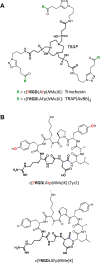PET/CT imaging of head-and-neck and pancreatic cancer in humans by targeting the "Cancer Integrin" αvβ6 with Ga-68-Trivehexin
- PMID: 34559266
- PMCID: PMC8460406
- DOI: 10.1007/s00259-021-05559-x
PET/CT imaging of head-and-neck and pancreatic cancer in humans by targeting the "Cancer Integrin" αvβ6 with Ga-68-Trivehexin
Abstract
Purpose: To develop a new probe for the αvβ6-integrin and assess its potential for PET imaging of carcinomas.
Methods: Ga-68-Trivehexin was synthesized by trimerization of the optimized αvβ6-integrin selective cyclic nonapeptide Tyr2 (sequence: c[YRGDLAYp(NMe)K]) on the TRAP chelator core, followed by automated labeling with Ga-68. The tracer was characterized by ELISA for activities towards integrin subtypes αvβ6, αvβ8, αvβ3, and α5β1, as well as by cell binding assays on H2009 (αvβ6-positive) and MDA-MB-231 (αvβ6-negative) cells. SCID-mice bearing subcutaneous xenografts of the same cell lines were used for dynamic (90 min) and static (75 min p.i.) µPET imaging, as well as for biodistribution (90 min p.i.). Structure-activity-relationships were established by comparison with the predecessor compound Ga-68-TRAP(AvB6)3. Ga-68-Trivehexin was tested for in-human PET/CT imaging of HNSCC, parotideal adenocarcinoma, and metastatic PDAC.
Results: Ga-68-Trivehexin showed a high αvβ6-integrin affinity (IC50 = 0.047 nM), selectivity over other subtypes (IC50-based factors: αvβ8, 131; αvβ3, 57; α5β1, 468), blockable uptake in H2009 cells, and negligible uptake in MDA-MB-231 cells. Biodistribution and preclinical PET imaging confirmed a high target-specific uptake in tumor and a low non-specific uptake in other organs and tissues except the excretory organs (kidneys and urinary bladder). Preclinical PET corresponded well to in-human results, showing high and persistent uptake in metastatic PDAC and HNSCC (SUVmax = 10-13) as well as in kidneys/urine. Ga-68-Trivehexin enabled PET/CT imaging of small PDAC metastases and showed high uptake in HNSCC but not in tumor-associated inflammation.
Conclusions: Ga-68-Trivehexin is a valuable probe for imaging of αvβ6-integrin expression in human cancers.
Keywords: Carcinoma; Gallium-68; Integrins; Positron emission tomography.
© 2021. The Author(s).
Conflict of interest statement
N.G.Q., K.S., and J.N. are co-inventors of patents related to 68 Ga-Trivehexin. J.N. is shareholder of TRIMT GmbH (Radeberg, Germany), which is active in the field of radiopharmaceutical develeopment.
Figures





References
-
- Sontag S. Illness as metaphor. Farrar, Straus & Giroux, New York, 1978, ISBN: 978-0-374-17443-9.
-
- Mukherjee S. The emperor of all maladies: a biography of cancer. Scribner, New York, 2010, ISBN: 978-1-4391-0795-9.
-
- Virchow R. Die krankhaften Geschwülste. Berlin: August Hirschwald; 1863.
-
- Brooks PC, Clark RAF, Cheresh DA. Requirement Of Vascular Integrin αvβ3 For Angiogenesis. Science. 1994;264:569–571. - PubMed
MeSH terms
Substances
LinkOut - more resources
Full Text Sources
Other Literature Sources
Medical
Miscellaneous

